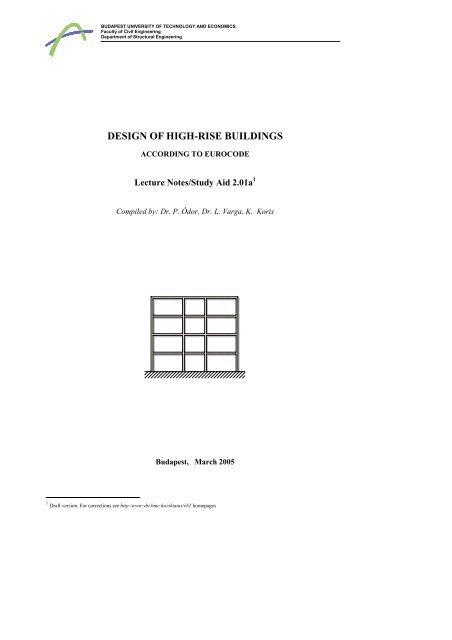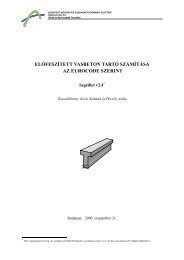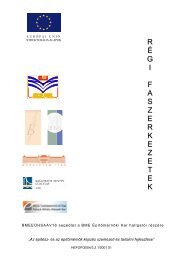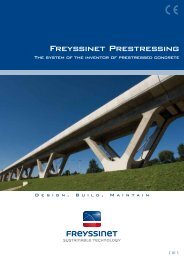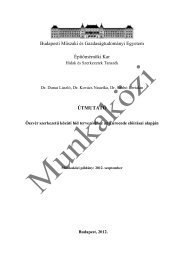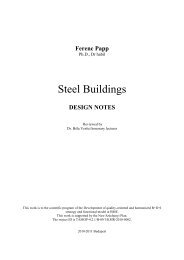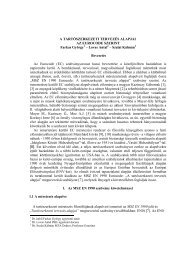DESIGN OF HIGH-RISE BUILDINGS
DESIGN OF HIGH-RISE BUILDINGS
DESIGN OF HIGH-RISE BUILDINGS
You also want an ePaper? Increase the reach of your titles
YUMPU automatically turns print PDFs into web optimized ePapers that Google loves.
BUDAPEST UNIVERSITY <strong>OF</strong> TECHNOLOGY AND ECONOMICS<br />
Faculty of Civil Engineering<br />
Department of Structural Engineering<br />
<strong>DESIGN</strong> <strong>OF</strong> <strong>HIGH</strong>-<strong>RISE</strong> <strong>BUILDINGS</strong><br />
ACCORDING TO EUROCODE<br />
Lecture Notes/Study Aid 2.01a 1<br />
Compiled by: Dr. P. Ódor, Dr. L. Varga, K. Koris<br />
Budapest, March 2005<br />
1 Draft version. For corrections see http:/www.vbt.bme.hu/oktatas/vb2 homepages
INDEX<br />
1<br />
Design of High Rise Buildings According to the EUROCODE - v2.01<br />
1.1 Geometry .......................................................................................................................... 2<br />
1.2 Materials........................................................................................................................... 2<br />
1.3 Loads ................................................................................................................................ 3<br />
1.3.1 Self weight and dead loads....................................................................................... 3<br />
1.3.2 Imposed loads........................................................................................................... 4<br />
Snow load............................................................................................................................. 4<br />
1.4 Codes, manuals and computer programs.......................................................................... 7<br />
2.1 Bending moments and shear forces of beam G1.............................................................. 7<br />
2.1.1 Bending moments due to vertical loads ................................................................... 7<br />
2.1.2 Bending moments due to horizontal loads ............................................................... 7<br />
2.2 Checking the sizes of beam G1 ........................................................................................ 8<br />
2.3 Forces and moments, sizing of column O1 ...................................................................... 8<br />
3.1 Preparation for calculation ............................................................................................... 9<br />
The structure, the coordinates .............................................................................................. 9<br />
3.2 Loads .............................................................................................................................. 10<br />
3.3 Load cases ...................................................................................................................... 10<br />
3.4 Ultimate forces and bending moments........................................................................... 13<br />
3.4.1 Bending moments................................................................................................... 13<br />
3.4.2 Axial force on the column...................................................................................... 13<br />
3.4.3 Shear force in the beam.......................................................................................... 14<br />
3.4.4 Appropriate axial loads and bending moments...................................................... 14<br />
3.5 Analysing of beam.......................................................................................................... 14<br />
3.5.1 The bending moment.............................................................................................. 14<br />
3.5.2 Analysis for shear................................................................................................... 16<br />
3.6 Analysis of column O1................................................................................................... 18<br />
3.6.1 Initial loads and bending moments......................................................................... 18<br />
3.6.2 Buckling length of columns ................................................................................... 18<br />
3.6.3 Inrcements in lateral displacement......................................................................... 20<br />
3.6.4 Control of column section...................................................................................... 21
1. Initial data<br />
1.1 Geometry<br />
Geometry according to the data sheet.<br />
z<br />
y<br />
1.2 Materials<br />
Grade of materials:<br />
x<br />
x<br />
b b<br />
O1<br />
G1<br />
O1<br />
n⋅b<br />
2<br />
Design of High Rise Buildings According to the EUROCODE - v2.01<br />
Concrete Reinforcement<br />
Grade C16/20 C20/25 C25/30<br />
fck [N/mm 2 ] 16 20 25<br />
fcd [N/mm 2 ] 10,7 12 15<br />
fctm [N/mm2 ] 1,9 2,21 2,56<br />
fctd [N/mm2 ] 0,89 1,03 1,2<br />
Ecm [kN/mm2 ] 27,4 28,8 30,5<br />
4<br />
3<br />
2<br />
1<br />
0<br />
l<br />
a<br />
l<br />
Grade B 50.36 B 60.40 B 60.50<br />
fyk [N/mm 2 ] 360 400 500<br />
fyd [N/mm 2 ] 313 348 435<br />
εsu<br />
ξc0<br />
3⋅h2<br />
h1<br />
ξ'c0<br />
z<br />
y<br />
O1<br />
l a l<br />
[%] 2,5 2,5 2,5<br />
G1<br />
0,55 0,53 0,49<br />
1,45 1,59 2,11
1.3 Loads<br />
1.3.1 Self weight and dead loads<br />
3<br />
Design of High Rise Buildings According to the EUROCODE - v2.01<br />
The thickness of the floor slab vslab ≈ lshorter/35 = b/35. The loads of the inner and roof floors<br />
will differ due to the different layers and live load. See an example of interior floor slab layers:<br />
Material of layers Thickness (v)<br />
[mm]<br />
Density (ρ)<br />
[kN/m3 Weight (gi )<br />
] [kN/m2 ]<br />
floor tile 10 23 0,23<br />
cement mortar 20 22 0,44<br />
screed 40 22 0,88<br />
techn. insulation - - -<br />
mineral wool 30 0,5 0,015<br />
in situ r.c. slab vslab 25 vslab⋅25<br />
plaster 15 20 0,3<br />
partition wall 2,5<br />
The self weight and the dead load of layers together: gk = Σgi<br />
See an example of roof floor slab layers:<br />
Material of layers Thickness (v)<br />
[mm]<br />
Density (ρ)<br />
[kN/m3] Weight (gi )<br />
[kN/m2 ]<br />
bit. water proofing. 4 12 0,05<br />
heat insulation 100 1,6 0,16<br />
moisture barrier 2 12 0,025<br />
breeze concrete 60 22 1,32<br />
in situ r.c. slab vslab 25 vslab⋅25<br />
plaster 15 20 0,3<br />
The self weight and the dead load of layers together: gkf = Σgi<br />
To calculate the self weight of beam G1 we assume its sizes as follows:<br />
height:<br />
width:<br />
l<br />
hg ≈<br />
12<br />
b<br />
g<br />
≈<br />
h<br />
g<br />
1 , 5 ÷ 2,<br />
0<br />
Characteristic value of self weight: gbeam = (hg - vslab)⋅bg⋅ρrc<br />
Safety factor for self weights and dead loads: γG = 1,35<br />
G1<br />
l a l<br />
bg<br />
hg
1.3.2 Imposed loads<br />
a.) Imposed loads on the interior floor slabs<br />
4<br />
Design of High Rise Buildings According to the EUROCODE - v2.01<br />
See the characteristic value of the imposed load (q) on the data sheet. Safety factor: γQ = 1,5;<br />
the combination factor ψ 0 = 0,<br />
7 (for imposed loads in case of flats, dwelling houses, office<br />
buildings, areas for assembly and shops).<br />
b.) Meteorological loads<br />
Snow load<br />
The design value of the snow load:<br />
sd = γs⋅s<br />
where: s projected snow load on the horizontal surface of roofs inclined by α<br />
γs = 1,5 safety factor for snow load.<br />
The projected snow load on a horizontal surface can be taken as:<br />
s = µi⋅Ce⋅Ct⋅sk<br />
where: sk characteristic snow load, in Hungary its value may be computed as follows:<br />
⎛ A ⎞<br />
2<br />
sk = 0,<br />
25⋅<br />
⎜1+<br />
⎟ [kN/m ]<br />
⎝ 100 ⎠<br />
but: sk ≥ 1,25 kN/m 2 in zone I., (West-Hungary)<br />
sk ≥ 1,00 kN/m 2 in zone II., (Hungary, except the Western part)<br />
A – height of the area above Baltic Sea level [m].<br />
Ce reduction factor due to the wind effect; in case of usual weather condition it is 1,0.<br />
This factor is less than 1,0 if the wind is generally very strong.<br />
Ct reduction factor due to the heat effect, at normally isolated roofs it is 1,0. This factor<br />
is less than 1,0 if the loss of the heat through the roof is high, and it reduces the snow<br />
depth.<br />
µi shape factor for the snow load, in case of inclination of the roof α=0 0 its value is<br />
µi=0,8.<br />
The combination factor for the snow load:<br />
ψ<br />
0 = 0,<br />
6
- Wind load:<br />
5<br />
Design of High Rise Buildings According to the EUROCODE - v2.01<br />
The horizontal wind load in longitudinal direction of the structure (in direction x) should<br />
be taken by shear walls. In transverse direction of the building (y) the frame itself will<br />
resist the wind load, because the frame is side-swaying. The frame should be analysed for<br />
the horizontal wind load, so the columns are unbraced. The wind load should be<br />
calculated for a b wide facade of a frame, where b is the distance between the frames.<br />
Design wind pressure, perpendicular to the building facade<br />
wd = γw⋅we<br />
where: we wind pressure, perpendicular to the building facade<br />
γw = 1,5 safety factor for the wind load.<br />
The wind pressure, perpendicular to the building’s facade:<br />
we = qref ⋅ce(ze)⋅cpe<br />
where: qref<br />
the average wind pressure, it is the characteristic value:<br />
qref =<br />
ρ 2<br />
ref<br />
v [N/m<br />
2<br />
2 ]<br />
where: ρ density of the air, depending on the height above sea level, the<br />
temperature and the air pressure, in general case it may be assumed<br />
as 1,25 kg/m 3 .<br />
vref the reference value of the wind speed, in Hungary its value is<br />
20 m/s.<br />
Substituting the values above, in Hungary a value of qref = 0,25 kN/m 2 should be<br />
taken.<br />
ce(ze) topographical factor, its value depends on the topography of the surroundings in<br />
function of the reference height above sea level ze. See the topographical<br />
categories in Table:<br />
Topographical conditions<br />
I. Open country, with no obstruction<br />
Open country with scattered wind break (rural area with small houses or<br />
II.<br />
trees<br />
III. Outskirts, or industrial zones, steady forest,<br />
City zone, where at least the 15 % of the ground is covered with buildings<br />
IV.<br />
higher than 15 meter<br />
The topographical factor can be obtained from the diagram on the next page.
z<br />
[m]<br />
20<br />
10<br />
50<br />
20<br />
10<br />
6<br />
Design of High Rise Buildings According to the EUROCODE - v2.01<br />
In case of wind load on the vertical surface of the building the EUROCODE<br />
classifies different zones with different wind pressures. If the height of the<br />
building does not exceed its width, it is enough to take only one zone into<br />
consideration. We use that case when the reference height is equal to the height<br />
of the structure:<br />
ze = H = mf + mt + h.<br />
cpe the outer pressure coefficient depends on the area of the surface on which the<br />
wind pressure should be calculated and may be obtained from equations below:<br />
cpe = cpe,1<br />
if A ≤ 1 m 2<br />
cpe = cpe,1 + (cpe,10 - cpe,1)⋅log10A if 1 m 2 < A < 10 m 2<br />
cpe = cpe,10<br />
5<br />
2<br />
0 1 2 3 4 5 ce(z)<br />
if 10 m 2 ≤ A<br />
Special analysis<br />
where cpe,1 and cpe,10 are the values of cpe to the loaded surface of A = 1 m 2 and<br />
A = 10 m 2 , respectively. The values of the outer pressure coefficient are<br />
summarized in table.<br />
The outer pressure coefficients in case of wind load on the vertical sidewall of<br />
the building:<br />
plan<br />
Wind<br />
B=a+2.l<br />
IV<br />
III<br />
D E<br />
II<br />
I
B/H<br />
7<br />
Design of High Rise Buildings According to the EUROCODE - v2.01<br />
Zones (surfaces)<br />
D E<br />
cpe,10 cpe,1 cpe,10 cpe,1<br />
≤ 1 +0,8 +1,0 -0,3<br />
≥ 4 +0,6 +1,0 -0,3<br />
Use linear interpolation for the interior values of b/H.<br />
The safety factor for the wind load: γw = 1,5; and the combination factor: ψ 0,<br />
6 .<br />
1.4 Codes, manuals and computer programs<br />
EUROCODE 1<br />
EUROCODE 2<br />
AXIS-VM7<br />
2. Sizing of load bearing elements<br />
2.1 Bending moments and shear forces of beam G1<br />
2.1.1 Bending moments due to vertical loads<br />
Design load acting on the interior floor:<br />
pd = b⋅(γG⋅gk + γQ⋅q) + γG⋅gbeam<br />
The ultimate bending moment due to the design load according<br />
to approximate calculation:<br />
( )<br />
M g,<br />
f pd<br />
≈<br />
−<br />
2<br />
l<br />
10,<br />
5<br />
2.1.2 Bending moments due to horizontal loads<br />
Assuming that beams are much stiffer than columns we get the side swaying shape of the<br />
columns due to wind load:<br />
wd<br />
P1<br />
P0<br />
inflection<br />
G1<br />
3⋅h2<br />
h1<br />
0 =<br />
The resultant of the wind load acting at<br />
height h1 + h2/2:<br />
P1 = 2,5⋅b⋅h2⋅wd<br />
The resultant of wind load at height h1/2:<br />
P0 = (3⋅h2 + 0,5⋅h1)⋅b⋅wd<br />
pd<br />
l a l<br />
M<br />
( −)<br />
g,<br />
f
8<br />
Design of High Rise Buildings According to the EUROCODE - v2.01<br />
As the bending moment in the inflection point is zero and the stiffness of the columns against<br />
displacement are equal, the bending moment on the column due to the wind forces P0 and P1:<br />
P1<br />
h2<br />
M 1 = ± ⋅<br />
4 2<br />
P0<br />
h1<br />
M 2 = ± ⋅<br />
4 2<br />
The number 4 in the denominator shows the number of the columns having the same stiffness.<br />
The bending moment at the end of the left side of beam G1 due to wind load, approximately:<br />
( −)<br />
( )<br />
M g , v = M1 + M2 (as a matter of fact, M g , v<br />
−
9<br />
Design of High Rise Buildings According to the EUROCODE - v2.01<br />
When sizing the column section we take into consideration only the axial force due to vertical<br />
loads. The bending moments should be taken into consideration only in exact method<br />
calculating reinforcement.<br />
The characteristic value of the column’s self weight:<br />
gcol = bcol⋅hcol⋅ρrc<br />
The sizes of the column due to upward decreasing load may be even decreased. As the length<br />
of steel bars may be about two levels long, the section of the column should be the same along<br />
two levels. Therefore it may be taken, that above section "2" we use a smaller section than at<br />
the lower levels. In this case two sections of the column should be analysed.<br />
The axial forces on level "0" and "2" due to vertical loads:<br />
⎛ l + a ⎞<br />
[ γ G ⋅ ( 3 ⋅ g k + g kf ) + ( γ Q ⋅ 3 ⋅ q + sd<br />
) ] + 4 ⋅ ⎜b<br />
+ ⎟ ⋅ γ G ⋅ g beam + ( h1<br />
+ 3 ⋅ h2<br />
) ⋅ G g col<br />
0 l + a<br />
N Sd = b ⋅<br />
γ ⋅<br />
2<br />
⎝ 2 ⎠<br />
⎛ l + a ⎞<br />
[ γ G ⋅ ( g k + g kf ) + ( γ Q ⋅ q + sd<br />
) ] + 2 ⋅ ⎜b<br />
+ ⎟ ⋅ γ G ⋅ g beam + 2 ⋅ h2<br />
⋅ G g col<br />
2 l + a<br />
N Sd = b ⋅<br />
γ ⋅<br />
2<br />
⎝ 2 ⎠<br />
The required area of the concrete, neglecting the reinforcement:<br />
A<br />
c,<br />
i<br />
N<br />
=<br />
α ⋅ f<br />
i<br />
Sd<br />
cd<br />
The assumed section of the column will be appropiate, if the assumed area is bigger than the<br />
required:<br />
A = b ⋅ h<br />
c,<br />
i ≤ Ac<br />
, i,<br />
appl<br />
col<br />
col<br />
Otherwise the sizes of the section should be increased, and the recalculation should be started<br />
with the recalculation of the selfweight. When sizing, please pay attention to the rule that the<br />
smallest size of the column section is 200 mm, and generally the height of section should not be<br />
bigger than four times their width.<br />
3. Exact analysis<br />
3.1 Preparation for calculation<br />
The exact calculation should be<br />
made with the computer program<br />
AXIS-VM7.<br />
The structure, the coordinates<br />
Prepare the data for the computer<br />
program as follows:<br />
z<br />
y<br />
5<br />
4<br />
3<br />
2<br />
1<br />
10<br />
9<br />
8<br />
7<br />
6<br />
25<br />
14<br />
13<br />
12<br />
11<br />
l a l<br />
20<br />
19<br />
18<br />
17<br />
16<br />
h1 h2 h2 h2
- coordinates of the joints (node),<br />
10<br />
Design of High Rise Buildings According to the EUROCODE - v2.01<br />
- sizes of the cross-section of columns and beams, respectively (it may be calculated neglecting<br />
the reinforcement, that is gross section),<br />
- Young modulus of concrete (Ec,eff).<br />
3.2 Loads<br />
The loading from the slabs onto the<br />
beam G1 may be taken exactly or<br />
approximately.<br />
Using the exact method the loading area<br />
of beam G1 will be trapezoidal as seen in<br />
the figure. In that case the reactions of<br />
beam G2 should be taken into account on<br />
the column as a concentrated load. Even<br />
the self weight gbeam of beam G1 should<br />
be taken into calculation.<br />
Using approximate method it may be<br />
assumed that the total load is transferred<br />
to the beam G1 with a rectangular shaped<br />
loading scheme, as it can be seen in<br />
figure. The frame should be partially<br />
loaded with the imposed load. All loads<br />
are UDL.<br />
3.3 Load cases<br />
TE1: The total load is the dead loads of<br />
the interior and roof floors (b⋅gk, b⋅gkf).<br />
If the program does not calculate the self<br />
weight of beams and columns (gbeam, gcol)<br />
automatically, these loads should be<br />
added to this load case. More exact result<br />
will be produced with consideration of<br />
the self weight of beam G2 (only its part<br />
under the slab) in the joints as<br />
concentrated loads (except joints 1, 6, 11,<br />
16).<br />
G1<br />
G1<br />
G1<br />
45°<br />
l<br />
G2<br />
a<br />
l a<br />
l<br />
l<br />
b b<br />
For self weight: gk vagy gkf<br />
For imposed load: q<br />
gk⋅b (for roof slab: gkf ⋅b)<br />
q⋅b<br />
gger<br />
b⋅gkf<br />
b⋅gk
11<br />
Design of High Rise Buildings According to the EUROCODE - v2.01<br />
TE2: Partial loading with imposed load (b⋅q) on slabs as seen in figure. This load case<br />
( + )<br />
produces the ultimate (maximum) positive midspan bending moment in beam G1 ( M Sd , k ), and<br />
the bending moment in column O1 at level "0" M ) .<br />
k<br />
Influence line for bending moments<br />
for section "k" in beam G1<br />
( Sd ,m<br />
TE3: Partial loading with imposed load (b⋅q) on slabs as seen in figure. This load case<br />
( −)<br />
produces the ultimate (maximum) negative support bending moment in beam G1 ( M Sd , l ), and<br />
its shear force V ), .<br />
l<br />
( Sd ,l<br />
Influence line for bending moments<br />
for section "l" in beam G1<br />
TE4: Partial loading with imposed load (b⋅q) on slabs as seen in figure. This load case<br />
produces the ultimate (maximum) bending moment due to the vertical load at level "2" of<br />
column O1 M ) .<br />
( Sd ,n<br />
n<br />
Influence line for bending moments<br />
for section "n" in column O1<br />
m<br />
Influence line for bending moments<br />
for section "m" in column O1<br />
l<br />
Influence line for shear forces for<br />
section "l" in beam G1<br />
b⋅q<br />
b⋅q<br />
b⋅q
12<br />
Design of High Rise Buildings According to the EUROCODE - v2.01<br />
TE5: Partial loading with imposed load (b⋅q) on slabs as seen in figure. This load case<br />
produces the ultimate (maximum) axial force in column O1 N , N ) .<br />
TE6: Total snow load on a roof slab<br />
( Sd , m Sd , n<br />
TE7: The wind load (calculated in Chapter 1.3.2) for compression and suction respectively,<br />
should be placed onto the structure, as shown in figure.<br />
1<br />
p wind<br />
n<br />
m<br />
Influence line for axial force for<br />
sections "m" and "n" in column O1<br />
2<br />
pwind<br />
b⋅q<br />
b⋅sd<br />
1<br />
p wind = wd ⋅b (surface D)<br />
2<br />
p wind = wd ⋅b (surface E)<br />
(see Chapter 1.3.2 )
3.4 Ultimate forces and bending moments<br />
13<br />
Design of High Rise Buildings According to the EUROCODE - v2.01<br />
The ultimate bending moments, shear forces and axial forces should be compiled from the<br />
combinations of load cases.<br />
3.4.1 Bending moments<br />
The ultimate positive bending moment in section "k" of beam G1 will be obtained from the<br />
load combination as follows:<br />
( ) + γ ⋅ M ( TE2)<br />
+ γ ⋅ ψ M ( TE7)<br />
M M<br />
⋅<br />
( + )<br />
Sd , k = γ G ⋅ k TE1 Q k<br />
Q 0 k<br />
where Mk(TEi) is the bending moment in section "k" from the load case "i". The value of<br />
combination factor ψ 0 in case of flats, dwelling houses, offices, assembly buildings is<br />
ψ 0 = 0,<br />
7 , in case of snow and wind load it is ψ 0 = 0,<br />
6.<br />
The ultimate negative bending moment in section "l" of beam G1 will be obtained from the<br />
load combination as follows:<br />
( ) + γ ⋅ M ( TE3)<br />
+ γ ⋅ψ<br />
⋅ M ( TE6)<br />
+ γ ⋅ψ<br />
M ( TE7)<br />
M M<br />
⋅<br />
( −)<br />
Sd , l = γ G ⋅ l TE1 Q l<br />
Q 0 l<br />
Q 0 l<br />
When calculating the maximal bending moment in column O1 it can not be predicted, which<br />
load combination provides the bigger moment, either the imposed load on slab or the wind load<br />
should be beneficial. So the ultimate bending moment in section "m" of column O1 will be<br />
obtained from the load combinations as follows:<br />
M<br />
Sd , m<br />
⎧γ<br />
= max⎨<br />
⎩γ<br />
G<br />
G<br />
⋅ M<br />
⋅ M<br />
m<br />
m<br />
( TE1)<br />
+ γ Q ⋅ M m ( TE2)<br />
± γ Q ⋅ψ<br />
0 ⋅ M m ( TE7)<br />
( TE1)<br />
± γ ⋅ M ( TE7)<br />
+ γ ⋅ψ<br />
⋅ M ( TE2)<br />
Q<br />
m<br />
The sign of the bending moment from wind load may be positive or negative, depending on the<br />
direction of wind. The ultimate bending moment in section "n" of column O1 will be similarly<br />
obtained from the load combinations as follows:<br />
M<br />
Sd , n<br />
⎧γ<br />
= max⎨<br />
⎩γ<br />
G<br />
G<br />
⋅ M<br />
⋅ M<br />
3.4.2 Axial force on the column<br />
n<br />
n<br />
( TE1)<br />
+ γ Q ⋅ M n ( TE4)<br />
± γ Q ⋅ψ<br />
0 ⋅ M n ( TE7)<br />
( TE1)<br />
± γ ⋅ M ( TE7)<br />
+ γ ⋅ψ<br />
⋅ M ( TE4)<br />
Q<br />
n<br />
Q<br />
The ultimate axial force in sections "n" and "m" of column O1 arise from the load combination<br />
as follows:<br />
( ) + γ ⋅ N ( TE5)<br />
+ γ ⋅ ψ ⋅ N ( TE6)<br />
± γ ⋅ ψ N ( TE7)<br />
N ⋅<br />
and<br />
Sd , n = γ G ⋅ N n TE1 Q n<br />
Q 0 n<br />
Q 0 n<br />
( ) + γ ⋅ N ( TE5)<br />
+ γ ⋅ ψ ⋅ N ( TE6)<br />
± γ ⋅ ψ N ( TE7)<br />
N ⋅<br />
Sd , m = γ G ⋅ N m TE1 Q m<br />
Q 0 m<br />
Q 0 m<br />
Q<br />
0<br />
0<br />
n<br />
m<br />
Törölt: <br />
Formázott: Felsorolás és<br />
számozás
3.4.3 Shear force in the beam<br />
14<br />
Design of High Rise Buildings According to the EUROCODE - v2.01<br />
The ultimate shear force in sections "l" of beam G1 arise from the load combination as follows:<br />
( ) + γ ⋅V<br />
( TE3)<br />
+ γ ⋅ ψ ⋅V<br />
( TE6)<br />
+ γ ⋅ ψ V ( TE7)<br />
V ⋅<br />
Sd , l = γ G ⋅Vl<br />
TE1 Q l<br />
Q 0 l<br />
Q 0 l<br />
3.4.4 Appropriate axial loads and bending moments<br />
Analysing the column loads and bending moments we need the pair of loads and moments<br />
associated such:<br />
appr<br />
M Sd , m - and Sd m<br />
N , maximum axial force in section "m" and appropriate bending moment,<br />
appr<br />
N Sd , m - and M Sd , m maximum bending moment in section "m" and appropriate axial force,<br />
appr<br />
M Sd , n - and Sd n<br />
appr<br />
N Sd , n - and Sd n<br />
3.5 Analysing of beam<br />
3.5.1 The bending moment<br />
N , maximum axial force in section "n" and appropriate bending moment,<br />
M , maximum bending moment in section "n" and appropriate axial force.<br />
The reinforcement of beam G1 should be calculated in their midspan section ("k") and at the<br />
middle support section ("l").<br />
The section of the beam may be assumed as rectangular at the support and T shaped in the<br />
midfield. In case of T shaped sections the width of the compression zone depends on the sizes<br />
of the web, the slab thickness, the type of loading, the span of the beam, the support conditions<br />
and the lateral reinforcement. The width of compression zone along the whole beam in a<br />
symmetrical case:<br />
1<br />
= b + ⋅l<br />
0 < b<br />
5<br />
beff g<br />
at end beam:<br />
beff = bg<br />
+<br />
1<br />
10<br />
⋅l<br />
0<br />
< b<br />
1<br />
In the expressions above, the length l0 is the distance between the zero moment points of beams<br />
and l0 has a value as follows:<br />
l0 = 2⋅l in case of a cantilever beam,<br />
l0 = 0,75⋅l fixed end beam (used in this project),<br />
l0 = 0,85⋅l fixed end at one support and simply supported at the other one.<br />
The compression zone xc in case of T shaped sections (in<br />
the midspan) can be calculated using the equivalent<br />
equations for bending moments. Assuming that the<br />
compression zone is smaller than the slab thickness and no<br />
need for compression steel bars:<br />
beff<br />
b1 b1 bg b1 b1<br />
b<br />
d<br />
d'<br />
Vsl<br />
beff<br />
Asc<br />
As<br />
bg<br />
hg<br />
vlem<br />
hg
⎛ x ⎞<br />
−<br />
⎝ 2 ⎠<br />
c ( + )<br />
eff ⋅ xc<br />
⋅α<br />
⋅ f cd ⎜d<br />
⎟ = M Sd , k<br />
15<br />
Design of High Rise Buildings According to the EUROCODE - v2.01<br />
The effective height of the section may be taken as d ≈ hg - 50 mm (assuming 20 mm concrete<br />
cover, ∅10 stirrup, ∅20 main bars and 10 mm disadvantageous positioning of steel bars).<br />
xc<br />
If the condition ξ c = ≤ ξc<br />
0 is true, the tension bars will yield and there is no need for<br />
d<br />
compression bars. In this case the area of steel required can be obtained from the horizontal<br />
force equilibrium:<br />
A<br />
s,<br />
req<br />
b<br />
=<br />
eff<br />
⋅ x ⋅α<br />
⋅ f<br />
c<br />
f<br />
yd<br />
cd<br />
In case of ξ c > ξc<br />
0 the tension bars will not yield, and we should apply compression bars, too.<br />
The maximum bending moment of the section without a compression bar in case of just<br />
yielding the tension bars:<br />
M<br />
0<br />
= α ⋅<br />
f<br />
cd<br />
⋅b<br />
eff<br />
⋅ d<br />
2<br />
⋅ ξ<br />
c0<br />
⎛ ξc<br />
⎜1−<br />
⎝ 2<br />
0<br />
⎞<br />
⎟<br />
⎠<br />
The area of compression bars to equalize the difference between bending moments M0 and<br />
( + )<br />
M :<br />
A<br />
Sd , k<br />
( + )<br />
M Sd , k − M<br />
=<br />
f ⋅ d′<br />
0<br />
sc,<br />
req<br />
where d′ is the distance between the compression and tension bars.<br />
yd<br />
And the area of tension reinforcement in this case:<br />
A<br />
s,<br />
req<br />
= A<br />
sc,<br />
req<br />
b<br />
+<br />
eff<br />
⋅ d ⋅<br />
ξc0 f<br />
yd<br />
⋅α<br />
⋅ f<br />
cd<br />
.<br />
In case of a higher compression zone than the slab width, the equations of the area of steel<br />
required should be modified. The main reinforcement of the support section of beam G1 should<br />
( −)<br />
be calculated for bending moment M in the same way as for the midfield moment.<br />
Reinforcement details<br />
Sd , l<br />
Take care of the most important rules of reinforcement listed below:<br />
- there must be bars in every corners of the section,<br />
- the main bars should be fixed with stirrups,<br />
- the minimal area of tension bars:<br />
⎧0,<br />
6 ⋅bt<br />
⋅ d / f yk<br />
As<br />
min = max⎨<br />
⎩0,<br />
0015⋅<br />
bt<br />
⋅ d<br />
, where bt is the general width of the tensioned concrete ,
16<br />
Design of High Rise Buildings According to the EUROCODE - v2.01<br />
- the maximal area of bars (the tension and compression bars together): As,max = 0,04⋅Ac<br />
where Ac is the area of the concrete section,<br />
- the minimum distance between the main bars is the bigger of 20 mm and the diameter of<br />
bar,<br />
- the diameter of the main bars should be at least 8 mm; in case of fixing or distributor bars at<br />
least 6 mm,<br />
- bars in two or more lines should be placed above each other,<br />
- the minimal concrete cover is the bigger of 15 mm and the diameter of the main bar,<br />
- the one third of the midfield reinforcement should be provided above the support.<br />
3.5.2 Analysis of shear<br />
According to EC-2 the checking of the shear resistance of beams is based on the three<br />
resistance equations of the shear given with the following equations:<br />
a.) Shear resistance of a section without shear reinforcement:<br />
[ τ ⋅ k ⋅ ( 1,<br />
2 + ⋅ρ<br />
) ] ⋅b<br />
⋅ d<br />
= 40<br />
VRd1 Rd<br />
l g<br />
in this equation above:<br />
τ Rd = ( 0.<br />
25⋅<br />
fctk 0 . 05)<br />
/ γc<br />
- design value of shear strength,<br />
k = 1, 6 − d ≥ 1 - where d is in [m],<br />
( b ⋅ ) 0,<br />
02<br />
ρl = Asl / w d ≤ - proportional area of the tension bar,<br />
Asl – area of steel bars overlapping the checked section at least with a length of + lb<br />
net ,<br />
d ,<br />
b.) The maximal shear force taken by the pure concrete semi-members of the section without<br />
collapse of theses members:<br />
1<br />
= ⋅ ν ⋅ f cd ⋅b<br />
⋅ 0,<br />
9 ⋅ d<br />
2<br />
VRd 2 g ≥ VSd,l<br />
f ck<br />
where the factor of the effectiveness: ν = 0, 7 − ≥ 0,<br />
5<br />
200<br />
If the beam is not appropriate according to this analysis in b.), the sizes of the concrete section<br />
should be modified!<br />
c.) The shear resistance of the section with shear reinforcement:<br />
red<br />
Rd 3 = Vcd<br />
Vwd<br />
≥ V Sd , l<br />
V +<br />
in the equation above:<br />
V , - reduced shear force,<br />
red<br />
Sd l<br />
V = V - shear force taken by the concrete,<br />
cd<br />
Rd1
V<br />
wd<br />
17<br />
Design of High Rise Buildings According to the EUROCODE - v2.01<br />
Asw<br />
⋅ f ywd<br />
= ⋅ 0 , 9⋅<br />
d - shear force taken by the reinforcement, where<br />
s<br />
Asw - area of shear reinforcement,<br />
s – spacing of shear reinforcement,<br />
fywd – design strength of shear reinforcement.<br />
In those sections where the reduced shear force<br />
red<br />
Sd l<br />
red<br />
computed shear reinforcement should be provided to fulfil the requirement of VSd , l ≤ VRd<br />
3 . The<br />
V , is bigger than the shear resistance VRd1, the<br />
area of steel required for the shear can be computed from the inequality above. From the two<br />
unknown values either the area of steel bars (Asw) or the spacing (s) should be assumed.<br />
Remember the rules of reinforcement! The computed reinforcement must not be less than the<br />
minimal area of steel given in the Code. Bent up bars for shear in beams should be used with<br />
stirrups. In case bent up bars are used, at least the half of the ultimate shear force VSd,l should be<br />
taken by stirrups.<br />
The rules for shear reinforcement:<br />
Asw<br />
- The relative area of steel for shear: ρ w = ≥ ρw,<br />
min where Asw is the area of shear<br />
bg<br />
⋅ s<br />
reinforcement along a distance of s, and s is the distance between bars provided for shear.<br />
The minimal values of ρw,min given in EC2 can be seen in Table below:<br />
Grade of concrete<br />
Grade of reinforcement<br />
S220 S400 S500<br />
C12/15 and C20/25 0,0016 0,0009 0,0007<br />
C25/30 and C35/45 0,0024 0,0013 0,0011<br />
C40/50 and C50/60 0,0030 0,0016 0,0013<br />
- The limitation of the cracks due to tangential forces may be sufficient if the spacing of<br />
stirrups fulfil the requirements of the code. For this limitation the maximal spacing of<br />
stirrups are given in Table below:<br />
( ,<br />
VSd<br />
l − 3Vcd<br />
)<br />
ρwbg<br />
d<br />
[N/mm 2 ]<br />
spacing [mm]<br />
≤ 50 300<br />
75 200<br />
100 150<br />
150 100<br />
200 50<br />
- The inclination of shear reinforcement to the middle plane of the structural element should<br />
be 45º-90º.<br />
- The shear reinforcement should be anchored properly.<br />
- The maximum spacing (smax) of stirrups along the axis of the beam may be determined based<br />
on the conditions below:
1<br />
V ≤ Rd , then smax = 0,<br />
8⋅<br />
d ≤ 300 mm,<br />
5<br />
1<br />
2<br />
if VRd 2 ≤ VSd<br />
, l ≤ VRd<br />
2 , then smax = 0,<br />
6⋅<br />
d ≤ 300mm,<br />
5<br />
3<br />
2<br />
if V Rd 2 ≤ VSd<br />
, l , then smax = 0,<br />
3⋅<br />
d ≤ 200 mm.<br />
3<br />
if Sd , l V 2<br />
3.6 Analysis of column O1<br />
3.6.1 Initial loads and bending moments<br />
18<br />
Design of High Rise Buildings According to the EUROCODE - v2.01<br />
To analyse the column O1 we need the results of the computer analysis as follows:<br />
appr<br />
On level "0": N Sd , m ; M Sd , m<br />
M , ;<br />
Sd m<br />
appr<br />
N Sd , m<br />
appr<br />
On level "2": N Sd , n ; M Sd , n<br />
M , ;<br />
Sd n<br />
appr<br />
N Sd , n<br />
The column should be analysed in these sections to prove that they are sufficient. As it can not<br />
be decided in advance, which pair of load and bending moment will result the bigger effect, all<br />
cases should be calculated.<br />
3.6.2 Buckling length of columns<br />
The buckling length of reinforced concrete columns can be calculated with:<br />
l0 = β⋅lcol<br />
where lcol is the effective height of the column, and β is a factor in the function of the end<br />
conditions as follows:<br />
⎧1,<br />
0 + 0,<br />
15⋅<br />
in case of unbraced columns: β = min⎨<br />
⎩2,<br />
0 + 0,<br />
3⋅<br />
k<br />
in case of braced columns: β =<br />
( + k )<br />
ka b<br />
min<br />
⎧0,<br />
7 + 0,<br />
05⋅<br />
⎪<br />
⎨0,<br />
85 + 0,<br />
05⋅<br />
k<br />
⎪<br />
⎩1<br />
( + k )<br />
ka b<br />
min min<br />
In our project the frame is assumed to be unbraced in plane z-y,<br />
and braced in plane x-z. In the equations above the restraint<br />
coefficients ka and kb depend on the relative stiffness of the<br />
beams joining to the end of column, coefficient kmin is the lowest<br />
of these two values.<br />
Ibeam<br />
Ibeam<br />
l<br />
Icol,2<br />
Icol,1<br />
Icol,0<br />
a<br />
b<br />
Ibeam<br />
Ibeam<br />
a<br />
4<br />
3<br />
2<br />
1<br />
0<br />
3⋅h2<br />
h1
k ( or<br />
k ) =<br />
a<br />
where:<br />
b<br />
∑<br />
Ec<br />
⋅ I<br />
lcol<br />
Ec<br />
⋅α<br />
⋅ I<br />
l<br />
∑<br />
beam<br />
col<br />
beam<br />
19<br />
Design of High Rise Buildings According to the EUROCODE - v2.01<br />
Ec - the Young-modulus of concrete,<br />
Icol - inertia if columns are connected to the joint,<br />
lcol - effective height of the column connected to the joint,<br />
Ibeam - inertia if beams are connected to the joint,<br />
Lbeam - effective length of the beam connected to the joint,<br />
α - factor taking into consideration the end condition of the other end of the beam, its value is<br />
as follows:<br />
α = 1 if the other end is fixed (use this case in the project),<br />
α = 0,5 if the other end is hinged,<br />
α = 0 if the other end is free (cantilever).<br />
At the end of a column where there is a pinned joint the value of k may be assumed as k = ∞.<br />
If the end of the column is fixed (see in our project at level “0”), then k = 0. In the project the<br />
buckling length of the column above the levels "0" and "2" should be determined in plane x-z<br />
and y-z, respectively. For the inertia of beam G2 running in direction x it may be assumed that<br />
Ig,x ≥ Ibeam, where Ig,y = Ig is the inertia of the beam G1.<br />
To go on with the analysis we need the slenderness of the column:<br />
λ =<br />
l<br />
0<br />
I<br />
A<br />
col<br />
c,<br />
col<br />
where Icol and Ac,col are the inertia and the area of the cross-section of the column (assuming<br />
non-cracked, concrete section).<br />
The column may be assumed as stub, and the effect of lateral deflections may be neglected if<br />
the slenderness (in plane y-z) fulfils the requirements:<br />
⎧ Ac<br />
, col ⋅ f<br />
⎪1,<br />
5<br />
λ < min⎨<br />
NSd<br />
⎪<br />
⎩25<br />
cd<br />
If the column is a stub and the frame is braced and the slenderness of the column is smaller<br />
than the critical slenderness, the column can be analysed for the axial force NSd and the bending<br />
appr<br />
appr<br />
moment M Sd (the bending moment M Sd must not be smaller than NSd⋅hcol/20). The critical<br />
slenderness:<br />
λ<br />
krit<br />
⎛ eo1<br />
⎞<br />
= 25<br />
⎜<br />
⎜2<br />
−<br />
⎟<br />
⎝ eo2<br />
⎠
20<br />
Design of High Rise Buildings According to the EUROCODE - v2.01<br />
where eo1 and eo2 are the eccentricities of the axial force at the two ends of the column (|eo1| ≤<br />
|eo2|).<br />
If the column slenderness is lower than 140 ( λ ≤ 140 ), the columns should be analysed for the<br />
pair of axial force and bending moment as follows:<br />
NSd; MSd = NSd⋅etot<br />
where etot is the eccentricity of the column in the middle section.<br />
3.6.3 Increments in lateral displacement<br />
The eccentricity of the column in the middle section:<br />
etot = eo + ea + e2<br />
In the equation above the eo is the eccentricity due to the initial axial force and bending<br />
moment:<br />
⎧0,<br />
6 ⋅ e<br />
eo = max⎨<br />
⎩0,<br />
4 ⋅ e<br />
o2<br />
o2<br />
+ 0,<br />
4 ⋅ e<br />
o1<br />
where eo1 and eo2 are the eccentricities of the axial force on the two ends of the column (|eo1|<br />
≤ |eo2|).<br />
ea is the eccentricity due to construction inaccuracy:<br />
ea =<br />
l0<br />
ν<br />
2<br />
where l 0 is the buckling length of the column, ν is the slanting of the building:<br />
⎧ 1<br />
⎪<br />
ν = max<br />
100 ⋅<br />
⎨<br />
⎪ 1<br />
⎪⎩<br />
200<br />
lcol<br />
e2 is the second order eccentricity:<br />
2<br />
l0<br />
e2 = k 1 ⋅ κ<br />
10<br />
where: l 0 is the buckling length of the column,
⎧ λ<br />
⎪ − 0,<br />
75<br />
k 1 = ⎨20<br />
⎪⎩ 1<br />
f yd<br />
2 ⋅ k2<br />
Es<br />
κ =<br />
0,<br />
9 ⋅ d<br />
k<br />
2<br />
α ⋅ f<br />
≈<br />
α ⋅ f ⋅ A<br />
cd<br />
cd<br />
c,<br />
col<br />
if<br />
15 ≤ λ ≤ 35<br />
if<br />
λ > 35<br />
21<br />
Design of High Rise Buildings According to the EUROCODE - v2.01<br />
the curvature of the r.c. section loaded with axial force NSd and<br />
bending moment MSd = NSd⋅etot,<br />
⋅ A<br />
c,<br />
col<br />
+ f<br />
3.6.4 Control of column section<br />
yd<br />
+ f<br />
yd<br />
s<br />
⋅ A − N<br />
s<br />
cd<br />
Sd<br />
⋅ A − 0, 4 ⋅ f ⋅ A<br />
The total eccentricity in the section in plane x-z and y-z should be determined and the section<br />
should be analysed for biaxial eccentric compression with the eccentricities of etot,x és etot,y. The<br />
initial eccentricity of the column in direction x should be zero as the building is braced in that<br />
direction. But in that case the eccentricity due to inaccuracy and the second order eccentricity<br />
in that direction should be calculated. The control of the section may be performed with the<br />
simplified spherical interaction diagram of M-N. Using the interaction diagram (see below) the<br />
ultimate moment of resistant in direction x and y (MRd,x and MRd,y) may be obtained,<br />
respectively.<br />
The section is sufficient if:<br />
M<br />
M<br />
Sd , x<br />
Rd , x<br />
M<br />
+<br />
M<br />
Sd , y<br />
Rd , y<br />
≤ 1<br />
where MSd,x = NSd⋅ etot,x and MSd,y = NSd⋅ etot,y.<br />
N<br />
b⋅<br />
d ⋅α<br />
⋅<br />
2,40<br />
2,20<br />
2,00<br />
1,80<br />
1,60<br />
1,40<br />
1,20<br />
1,00<br />
0,80<br />
0,60<br />
0,40<br />
0,20<br />
0,00<br />
fcd<br />
0,00<br />
0,15<br />
0,30<br />
0,45<br />
µ = 0,60<br />
c,<br />
col<br />
≤ 1.<br />
As<br />
⋅ f yd<br />
µ =<br />
b ⋅ d ⋅ α ⋅ f<br />
0,05 0,10 0,15 0,20 0,25 0,30 0,35 0,40 0,45 0,50 0,55 0,60 0,65 0,70<br />
cd<br />
A's<br />
h d' d<br />
= µ′ =<br />
As<br />
b<br />
A′<br />
⋅ f ′<br />
s<br />
yd<br />
b ⋅ d ⋅ α ⋅ f<br />
M<br />
2<br />
b⋅<br />
d ⋅α<br />
⋅<br />
cd<br />
fcd
22<br />
Design of High Rise Buildings According to the EUROCODE - v2.01<br />
Interaction diagram for rectangular section with symmetrical reinforcement<br />
Designing the main bars of the reinforcement details should be taken into consideration. Here<br />
are the most important rules:<br />
- the smallest dimension of the column is 200 mm, and the longer side can not be bigger than<br />
four times the smallest,<br />
- bars should be placed in the corners of the column,<br />
- the smallest diameter of the main bars is 12 mm, the distances between the bars are the same<br />
as in case of beams,<br />
- the minimal area of steel required:<br />
⎧0,<br />
15⋅<br />
N Sd / f yd<br />
As,<br />
min = max⎨<br />
where Ac is the area of concrete section,<br />
⎩0,<br />
003⋅<br />
Ac<br />
- at the overlapping the area of reinforcement must not be bigger than the 8 % of the section<br />
area .<br />
The rules of shear reinforcement are the same as in case of beams. But take into consideration<br />
the rules listed below:<br />
- The minimal diameter of the links is the bigger of either 6mm or the one quarter of the main<br />
bar diameter.<br />
- The spacing between the stirrups may not be bigger than:<br />
⎧12 ⋅∅<br />
⎪<br />
s min = min⎨smallest<br />
dimension of the column where ∅ is diam. of the smallest main bar<br />
⎪<br />
⎩300<br />
mm<br />
The spacing above should be multiplied by 0,6 in case of:<br />
- overlapping, if the main bar diameter is at least 14 mm,<br />
- where a beam or slab is connected to the column along a length of the biggest dimension<br />
of the column.


